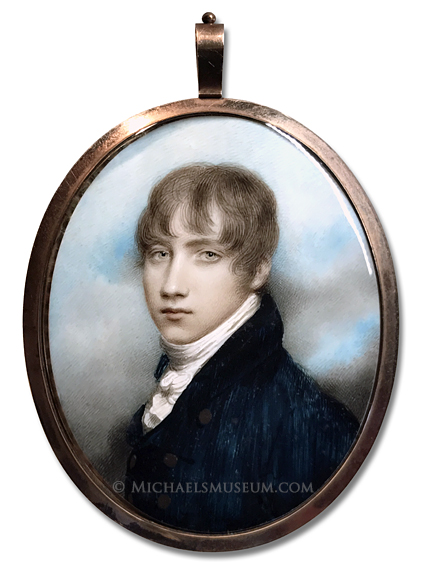| |
English Artist: Andrew Plimer

Young, Georgian Era Gentleman
Depicted with a Sky Background
English
circa 1795
by Andrew Plimer (1763-1837)
watercolor on ivory; housed in a gilt metal pendant frame
About the Artist: Andrew Plimer (1763-1837) was one of the most prolific miniaturists of England's golden age of miniature painting (late eighteenth and early nineteenth centuries), and his work is found in virtually every important collection, both public and private -- remarkable facts, considering his fanciful and adventurous youth. He and his older brother, Nathaniel Plimer (1757-1822, also a miniature portrait painter), were born in Wellington, Shropshire, sons of a clockmaker. Expected to follow in the family trade, the brothers were apprenticed at a young age; but neither of them took a liking to the profession of clock making. Fearful of what they saw as a life of drudgery, the two ran away from home (Andrew at age 16, Nathaniel at age 22). Joining a troop of gypsies, they wandered about Wales and the West of England for two years, fully embracing the gypsy lifestyle and earning their keep by painting decorative images and scenery on gypsy caravans. Upon ultimately departing their gypsy friends, the two brothers arrived to London in 1781, at which time Andrew found employment as a manservant to esteemed painter Richard Cosway. Nathaniel was similarly hired by Henry Bone. Andrew remained in Cosway's employment for four years, during which time Cosway also taught him the art of miniature painting. (Cosway later also taught Andrew's brother, Nathaniel.) Andrew left Cosway in 1785, setting up practice as a painter on his own account. He remained in London for most of his career, but he also traveled throughout Devon, Cornwall, the West of England, and Scotland. Exhibited at the Royal Academy of Arts (1786-1830). He is most admired for his portraits of children and young adults. His portraits of of men tend to be more realistic looking than those of women, which often appear idealized. He died in Brighton in 1837, at the age of 74, leaving a considerable amount of property to his heirs (a testament to his long and successful career as a painter). Listed by Benezit, Blättel (pages 720, 721), Foskett (pages 619, 620), and Schidlof (pages 642, 643).
|
|